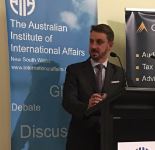International Crime
Dr James Cockayne is a strategist, international lawyer and author, currently head of a global think tank created by the UN General Assembly. On Tuesday 9 August he addressed an attentive audience at Glover Cottages on international strategies of organised crime.
Citing instances in his new book Hidden Power: The Strategic Logic of Organised Crime, James said that for international criminals, profits and power are intertwined. So are many crime gangs and governments. An example was mafia links with the United States Navy in World War Two, stemming from the fire and sinking in New York Harbour in 1941 of Normandy, the largest cruise liner in the North Atlantic in the thirties, now converted to carry troops. The mafia controlled the waterfront and US officials met with a wall of silence until Navy and the local DA cooperated with them. Among others, the mobster Lucky Luciano helped identify Nazi saboteurs who were brought to book. He was later released to Italy. Allied forces also sought cooperation with the Italian Mafia to identify coastline features prior to the invasion of Sicily.
Another mafia strategy was mergers and joint ventures with industry and where appropriate, government. Before Fidel Castro toppled the Cuban dictator Fulgencio Batista in the 1959 revolution, Batista had been partner in an integrated political alliance with the US mafia, and co-venturer with US banks, industrial ventures and unsavoury aspects of the tourist industry, many known and backed by the US government. After Castro took over, the US financed and trained Brigade 2506 comprising Cuban refugees, to attack Cuba and unseat Castro in April 1961. Neither The Bay of Pigs invasion nor other acts of terror and sabotage worked. Similar military force led to invasions and coups, some successful, others not, throughout the Caribbean and Central America in the sixties and seventies.
At present, James concluded, criminal mafias continue to determine political outcomes to suit their own agendas. Depending on what are perceived to be national interests, in some cases they are opposed by government agencies, in others there is cooperation. His last example was Mexico, where criminal groups have taken over the drug trade with devastating effects on the civilian population. The United States and Mexican governments are of course actively opposed to the gangs and their trade, but it continues. In the 1990s, an active task force of ambassadors and officials from several countries (with Australian participation) met regularly to consider ways to combat the trade. James agreed with an interlocutor that calling the trade a ‘war’ was not particularly helpful as it elevated the status of those involved. But as one US ambassador wryly observed at the time, the trade will continue to exist as long as there is a vigorous demand for the drugs north of the Mexican border and money to pay for it. Building a wall, as Donald Trump apparently wants to do, will not inhibit the trade, but simply force the traffickers to find ingenious ways around it.
Report by Richard Broinowski
